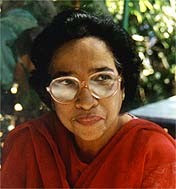
No trip to Rome is complete without a visit to the Vatican. Though standing in long serpentine queues is daunting, once inside that hallowed building, all is forgotten. It is a long way to the Sistine Chapel via gorgeously painted corridors, galleries, and museums, as the Chapel is not directly accessible from the exterior. Then on to the Basilica, which faces St. Peter’s Square, its silver and blue dome looming into the skies. Under the Basilica is the crypt, where the remains of popes and saints lie in solemn splendour, in their marble tombs.
Here also lies Queen Christina of Sweden, the only woman to be bestowed with such an honour. As in life so in death, she sought exclusivity. One wonders how a woman of her notoriety could have found a place in this hallowed sanctum that houses the tomb of St. Peter.
On the right side of the entrance to the Basilica, is Michael Angelo’s ‘Pieta’ – the famous sculpture of a young mother with a dead son in her arms. Adjacent to this is the monument of Queen Christina of Sweden, between two marble pillars. What irony that the Queen of a Protestant nation is interred in the most famous of Catholic churches! Though she converted to Catholicism in 1655, and was embraced into the faith by Pope Alexander VII himself, it was generally believed that she was skeptical about religion all through her life.
Christina was born to King Gustav II and Maria Eleanora of Brandenburg on December 8th 1626. Even as she was being born, the midwives called out ‘boy’ seeing how hairy she was. She defied the court soothsayers’ predictions that the child would be a boy. Her mother was sorely disappointed. It was probably this maternal rejection that contributed to her erratic behaviour in later life.
Christina was her father’s beloved child. In 1630, he recognized her as his legal heir to the throne. She accompanied him on his journeys, and the sound of gun fir was like music to her ears. She also received a sound education from a select group of tutors, and the subjects she studied ranged from Philosophy to Theology. She mastered a number of European languages in addition to her own mother tongue Swedish. As her father wanted her to be brought up like a prince, she was trained in various sports like horsemanship, and even tactics of war.
Christina was precocious for a young girl. When her father King Gustav died in the Battle of Lutzen, this ‘heir presumptive’ who was only six years old, insisted on being crowned queen, much against the advice of her Regent Axel Oxenstiern. Even while still a minor, she took part in Council meetings and interested herself in the governance of Sweden. In 1644, when she came of age, her status as queen was re-confirmed.
Christina was an intellectual, and engaged herself in dialogue with scholars and philosophers. She was a patron of Arts, Theatre and Ballet, and even considered herself an amateur actress.
But she was head strong and did not heed the advice of her councilors. She was instrumental in ending the 30-year war, before her country could acquire sufficient war booty. The majority of her subjects thought she had acted against the interests of her country. But some considered her an angel of peace.
However, Christina was a poor statesman. Her arbitrary decisions and extravagant ways created discontent in Court as well as among her subjects. She sold off or mortgaged Crown property to cover the expenses of her imprudence. Her foreign policy was flawed. When things spun out of hand, she abdicated, and in 1654, appointed her cousin Charles X Gustav as her successor.
Now she left Sweden donning men’s attire, and riding a white charger through Europe. She called herself Count Dohna. In Rome, Pope Alexander VII gave her a royal welcome, and the festivities lasted for several days. After she converted to Catholicism she became a favourite of the Vatican. Because of her wealth she was welcomed in high society, even though the ladies despised her for her mannish ways. But the men couldn’t stop fawning over her.
As her wealth dwindled, she was seized with a new restlessness. She moved out of Rome to Fontainebleau, and involved herself in political and religious intrigue. She wanted to become Queen of Naples. Betrayed by her servant Rinaldo Monaldachi, she had him promptly murdered. Europe was horrified, but she justified her action claiming judicial right and sovereign authority over members of her Court. When she returned to Rome, the Vatican cold shouldered her. After the death of her cousin, she tried to retrieve her crown in Sweden, but was rejected by her subjects. So she settled permanently in Rome.
Christina never married. She was more masculine than feminine in her ways, and loved cross dressing. She walked and talked like a man. She preferred male company, unless there were exceptionally beautiful women around. Then she shamelessly wooed them.
In her youth, she was in a lesbian relationship with a woman called Ebba Sparre, whom she called her ‘bed fellow.’ Even after Ebba was married, Christina wrote passionate letters to her. People thought she was a hermaphrodite, and the transgender community looked on her as their icon.
Christina died on April 19th, 1689. For many years she had a platonic love affair with Cardinal Decio Azzolino. She named him her heir before she died. Perhaps it was her wealth that bought her a place in the crypt of the Basilica.
In 1965, her body was exhumed to investigate whether she was a hermaphrodite. She had a normal female body. Perhaps her mother’s rejection of her biological sex played havoc with her sexuality and altered her behaviour and attitude towards the world.






